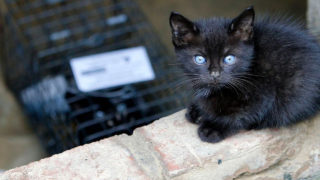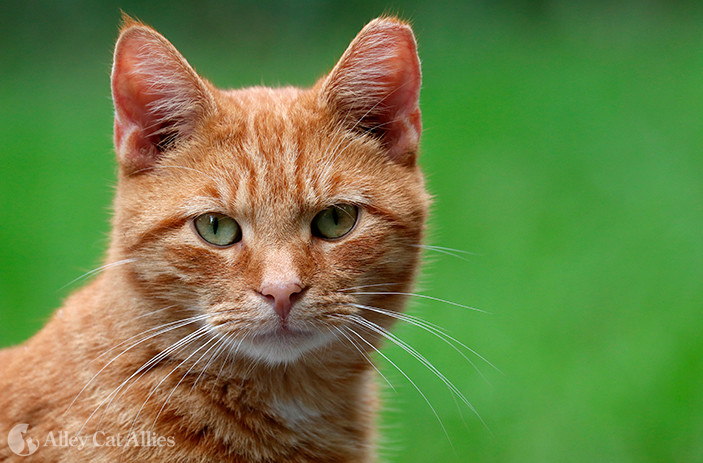How Long Have Domesticated Cats Been Around?
Did you know that not even a century ago, few cats lived entirely indoors at all? In fact, for more than 10,000 years, cats have lived outdoor lives, sharing the environment with birds and wildlife. Understanding cats’ place in history and human evolution reveals how very recently domestic cats came indoors and how millions of this species—who we call community cats—continue to live healthy lives outdoors today, as all domestic cats are biologically adapted to do.
Origins of the Domestic Cat
Cats began their unique relationship with humans 10,000 to 12,000 years ago in the Fertile Crescent, the geographic region where some of the earliest developments in human civilization occurred (encompassing modern day parts of West Asia). One such development was agriculture. As people abandoned their nomadic lifestyle and settled permanently to farm the land, stored grain attracted rodents.
Taking advantage of this new, abundant food source, Middle Eastern wildcats, or felix silvestris lybica, preyed on the rodents and decided to stick around these early towns, scavenging the garbage that all human societies inevitably producejust as community cats do today.
Over thousands of years, a new species of cat eventually evolved that naturally made its home around people: felis catus. Pet, stray, and feral cats (stray and feral cats are community cats) are all this same species, which we call the domestic cat.1
Cats Travel the World
Cats formed a mutually beneficial relationship with people, and some scientists argue that cats domesticated themselves.2 Especially prized as mousers on ships, cats traveled with people around the globe:
- A burial site in Cyprus provides the first archaeological evidence of humans and cats living side-by-side, as far back as 9,500 years ago. Cats must have been brought to the island intentionally by humans.3
- In ancient Egypt, cats were worshipped, mummified, and sometimes even dressed in golden jewelry to indicate the status of their owners.
- In 31 BC, Egypt became a province of the Roman Empire. Cats were introduced into Roman life, becoming truly widespread in Europe around the 4th century AD.4 A cat skeleton from this period shows the shortened skull of domestic cats today.5
- Geoffrey Chaucer mentioned a cat door in The Canterbury Tales in the 1380s.
- From Europe, cats boarded ships to the Americas, reportedly tagging along with Christopher Columbus, with the settlers at Jamestown, and aboard the Mayflower.
- Cats continued their service as mousers throughout history, even serving as official employees of the United States Postal Service as late as 19th and early 20th century America.6
- Towards the end of the 19th century, more Americans began to keep cats for their company as well as their utility. The first cat show was held at Madison Square Garden in 1895. By the end of World War I, cats were commonly accepted as house pets in the U.S.
Throughout all this time, cats were allowed to come and go freely from human householdseven President Calvin Coolidge’s cat had free rein to wander to and from the White House during the 1920s. As Sam Stall, author of 100 Cats Who Changed Civilization and The Cat Owner’s Manual, writes, “Back in Coolidge’s day no one thought of confining cats indoorsnot even one belonging to the president of the United States.”7
Catering to Cats: Inventing the Indoor Cat
Keeping cats indoors all the time was not possible nor was it even a goal until several important 20th century innovations: refrigeration, kitty litter, and the prevalence of spaying and neutering.
Even though these changes to our modern lifestyle make keeping cats inside possible, biologically, cats are the same as they were thousands of years ago. Their role in our society has evolved and broadened over the last hundred years, but their basic behaviors and needs haven’t changed.
Cat Food
Unlike dogs, who have undergone many physical changes since domestication and evolved to survive on an omnivorous diet, cats haven’t changed much, and still require a high-protein diet. Before the development of refrigeration and canned cat food in the 20th century, feeding indoor cats who could not supplement their diets by hunting would have been impossible for most Americans, who could not afford extra fresh meat or fish.8
Kitty Litter
Up until the 1950s, cats roamed American neighborhoods freely, using the great outdoors as their litter area. Pans filled with dirt or newspaper were used indoors by a few cat owners, but it wasn’t until the first clay litter was accidentally discovered in 1947 and the subsequent marketing of the Tidy Cats® brand in the 1960s that litter boxes really caught on. With the invention of cat litter, cats rocketed to popularity as indoor pets, but their outdoor survival skills remain.9
Spaying and Neutering
Until spaying and neutering pets became available and accessible around the 1930s, keeping intact cats indoors was messy business during mating season. Techniques had been developed for sterilizing livestock, but American households would have had a hard time finding a veterinarian trained to safely neuter pets before this time.10 Just as cats found their own food and litter areas outdoors, 20th century cats bred and gave birth outdoors as they have done since their origins in the Fertile Crescent 10,000 years ago.
While some of those cats’ offspring can, if brought into human contact when they are young enough, successfully be socialized and integrated into human homes, many cats remain outside and live the same outdoor lives they always have with or without human contact. Although generally adult community cats—who are not socialized to people or indoor life—cannot become indoor pets, neutering and returning them to their outdoor home improves their lives.
Cats are Part of Our Environment
In the thousands of years that cats have lived alongside people, indoor-only cats have only become common in the last 60 or 70 years—a negligible amount of time on an evolutionary scale.
Throughout human history, cats have always lived and thrived outside. It is only recently that we have begun to introduce reproduction control like spaying and neutering to bring them indoors. And also, bring the outdoors to them: using canned food and litter boxes to satisfy biological needs developed over thousands of years of living outdoors.
Although human civilization and domestic cats co-evolved side by side, the community cat population was not created by humans. Cats have lived outdoors for a long time; they are not new to the environment and they didn’t simply originate from lost pets or negligent pet owners. Instead, they have a place in the natural landscape.
Community cats deserve to live their lives outside just as they have for thousands of years. Indoor homes are not an option because they have not been socialized to live with humans. They would be scared and unhappy indoors. Their home is the outdoors and, just like squirrels, raccoons, and birds, they’re well suited to their outdoor home.
Accepting and acknowledging this simple reality is key to understanding and helping these animals. TNR is an act of compassion society can extend to them.
Just as many, many kind people place bird feeders, suet and bird houses in the gardens to help increase the odds of birds living through cold winters, many kinds people feed community cats and build outdoor shelters for them.
Through TNR, we further help cats by spaying and neutering them and having them vaccinated.
This is not only good for the cats, but also does a nice job of balancing needs and concerns of the human communities in which community cats live. People don’t want cats rounded up and killed. They do want to see cat populations stabilized and often appreciate when some of the behaviors manifested by intact cats are brought into check. TNR makes great public policy; it is a well considered, balanced approach to helping improve co-existence between outside cats and humans in our shared environment. This is why so many cities are adopting it. TNR stabilizes cat populations, greatly reduces the number of calls of concern about cats that municipalities receive, decreases euthanasia rates at shelters, and saves municipalities money.
- Driscoll, Carlos A. et al. “The Taming of the Cat.” Scientific American (2009): 71-72.
- Ibid.
- Ibid.
- Donalson, Malcolm Drew. The Domestic Cat in Roman Civilization. The Edwin Mellen Press, Lewiston, New York: 1999.
- Ibid.
- Weir, Harrison. Our Cats and All About Them. Fanciers’ Gazette, London: 1892.
- Stall, Sam. 100 Cats Who Changed Civilization. Quirk Books, Philadelphia: 2007.
- Bradshaw, John W.S., The Evolutionary Basis for the Feeding Behavior of Domestic Dogs (Canis familiaris) and Cats (Felis catus), 136(7) J Nutrition (2006).
- Rainbolt, Dusty. “The Best Idea,” Cat Fancy. (August 2010): 30-31.
- Grier, Katherine C. Pets in America: A History. University of North Carolina Press, Chapel Hill: 2006.
Founded in 1990, Alley Cat Allies is the leading advocacy organization for cats with a mission to transform and develop communities to protect and improve the lives of all cats and kittens. Together with our over 1.5 million supporters, we work toward a world where cats are valued and every community has humane and effective programs and policies to defend them.
Through our fearless advocacy, humane care, education and outreach, and law and policy activism, we equip and mobilize citizens, advocates, grassroots groups, shelters, veterinary professionals, and elected officials across the United States and around the world to improve their communities for cats through nonlethal, evidence-based approaches.
Our website is www.alleycat.org, and we are active on Facebook, X (Twitter), Instagram, LinkedIn and YouTube. Charlene Pedrolie is the President and Chief Operating Officer of Alley Cat Allies.


